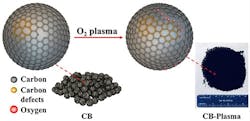Green Hydrogen Peroxide Process Looms
In effort to find a more-cost-effective and energy-efficient hydrogen peroxide (H2O2) production route, researchers at Rice University, Houston, have developed a localized and renewable generation method using inexpensive, metal-free carbon black (CB) treated with plasma. The simplicity of the process could allow more local generation of H2O2, avoiding the cost usually incurred for transporting it from centralized plants, say the researchers.
Figure 1. Scientists at Rice University have introduced plasma-treated carbon black as a simple and highly efficient catalyst for the production of hydrogen peroxide. Source: Tour Group/Yakobson Research Group/Rice University.
Its market — estimated at $5 billion/yr — is rapidly expanding, especially amid the COVID-19 pandemic, which has spurred H2O2’s wide use as a disinfectant in addition to its common uses in paper and pulp processing, wastewater treatment and chemical oxidation. The traditional energy-intensive anthraquinone process that produces most H2O2 requires expensive catalysts and generates large amounts of wastewater and toxic organic byproducts. Furthermore, transportation from centralized H2O2 generation facilities, and then local storage, account for a large portion of the chemical cost.
In contrast, the new process takes place under mild conditions in aqueous systems without organic solvents. Plasma processing creates defects in the structure of the carbon black particles, removing enough atoms to free space in the lattice for interactions to occur. When used as a catalyst, the defective particles, known as CB-Plasma, reduce oxygen to hydrogen peroxide with 100% Faradaic efficiency. A recent article in ACS Catalysis contains more detail.
“The electrochemical process outlined here needs no metal catalysts, and this will lower the cost and make the entire process far simpler,” says James Tour, who led the project at Rice. “Proper engineering of carbon structure could provide suitable active sites that reduce oxygen molecules while maintaining the O-O bond, so that hydrogen peroxide is the only product. Besides that, the metal-free design helps prevent the decomposition of hydrogen peroxide.”
“The selectivity towards peroxide rather than water originates not from carbon black per se but… from the specific defects created by plasma processing,” adds Rice materials theorist Boris Yakobson. “These catalytic defect sites favor the bonding of key intermediates for peroxide formation, lowering the reaction barrier and accelerating the desirable outcome.”
Tour notes CB-Plasma matches the efficiency of materials currently used to generate H2O2.
“Scaling this process is much easier than present methods, and it is so simple that even small units could be used to generate hydrogen peroxide at the sites of need,” Tour says. “The plasma-treating process is simple and quick, and no corrosive chemicals nor complicated separation processes are involved. However, the size of most commercial plasma cleaners is relatively small, which may hinder when we synthesize on a very large scale,” he explains.
The team is now working to improve the procedure to create defective catalysts with simple instruments so it better suits industry.
“We are working on these and are very close to success. You may see the results very soon,” he adds.
Tour believes that its defective CB catalyst could also be used in oxygen evolution reactions as part of the water-splitting process, and catalysts for zinc-air or lithium-air batteries. “Of course, our group has made some progress already in all these aspects,” he notes.
A couple of industrial firms have been in contact with the team to collaborate on further development, and admits his team could use help with scaling.

